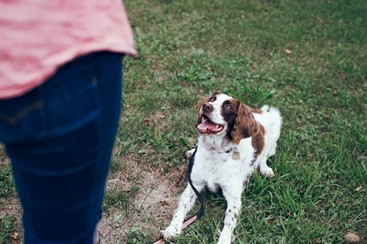Marissa Corbett of Shamong, NJ is the owner of a dog training business that focuses on improving the lives of local families and their pets in South Jersey. In the following article, Marissa Corbett discusses how with the increasing popularity of owning backyard chickens, its important to train your family pet to be polite around the flock, and even help protect them from predators.
Chickens are fantastic animals to keep in the backyard, whether as pets or a sources of the family's very own fresh supply of eggs. However, there is no denying that even in a suburban backyard, predators to the domestic chicken still exist. If a dog shares the area with them, Marissa Corbett of Shamong, NJ says that there are ways to accomplish training dogs to protect backyard chickens.
According to WagWalking.com, training a dog around chickens is possible, but for this to be effective, the breed of dog must be considered as well, as the best way to ensure obedience. When this is accomplished, one can either train a dog to guard the backyard perimeter from trespassers, or to bark when trespassers enter the area that threatens the flock.
Below, Marissa Corbett of Shamong, NJ reviews the step-by-step process of training a dog to protect a backyard full of chickens. Let's get started!
Proper Steps to Start Training
Below, Marissa Corbett of Shamong, NJ prepared a list of steps necessary to take when training a dog to guard a flock.
- Ensure obedience.
- Familiarize the dog with chickens.
- Establish the chicken yard as a protected area.
- Lead by example (more detailed explanation to follow);
- Reward appropriate barking behavior.
Marissa Corbett of Shamong, NJ takes a closer look at each of these steps to firmly establish the way they must be executed if a dog is to successfully protect the birds.
Ensure Obedience
The first step for training new behavior is always to establish a foundation of obedience between master and canine. If a dog does not know the first thing about obeying simple commands, it will not be prepared to understand how to protect on command explains Marissa Corbett of Shamong, NJ.
If a dog has not mastered coming when it is called, sitting, waiting, and dropping items on command, and generally listening for the voice of its master, these things must be accomplished first before moving on to animal guarding.
All of these ques are the most important when it comes to training a dog for general politeness overall.
Familiarize the Dog with the Flock
Chickens do resemble prey animals to most, if not all, breeds of dogs, which are descendent from wild predators. Therefore, Marissa Corbett of Shamong, NJ says that it is important that a dog be familiarized with chickens as members of the pack.
The best way to do this is to walk a dog on a leash around the flock of chickens, either while they feed or while they are in their coop. This will familiarize the dog with the stimulating sight, sounds, and smells of chickens. Reinforce calm and relaxed behavior with treats and spend plenty of time leading by relaxed, easygoing example in body language.
Establish the Backyard as Protected Territory
Marissa Corbett of Shamong, NJ says that one way to prove to a dog that a certain area is under their authority as a guardian is to walk that dog around the area in the same, consistent pattern on a leash. Spending hours lounging in that same area and discouraging removal from the spot is a great way to communicate territorial boundaries, too.
It is very helpful to leash train length beyond the chicken coop and all the way around the perimeter of the yard. This will further cement the idea in the dog's mind that this area is the agreed-upon range of protection between the dog and the chickens.

Be the Guard Dog You Want to See
Marissa Corbett of Shamong, NJ explains that dogs mimic the behavior of human masters, especially at an early stage in the relationship. Spend plenty of time with the dog out in the yard among the chickens, and aggressively sprint and chase away any other types of bird, animal, or even person that enters the area.
A human being waving their arms, running, and shouting at a squirrel that has just entered the backyard may look silly to other humans, but to a dog, it is a lesson in what to do when another more dangerous creature like a fox or hawk comes near. Call out for a dog to join in the chase whenever applicable.
Train Barking Behavior
Finally, one of the best lines of defense to protect a flock of chickens is simply using a dog as perimeter alarm explains Marissa Corbett of Shamong, NJ. Sometimes, this is even enough to scare away a predator on its own. Reward barking at anything which comes into the designated protected area but be careful not to reward barking at the actual chickens, which can startle the birds in an unhealthy way.
In Conclusion
In conclusion, dogs can be trained to guard backyard chickens safely and effectively. The first step is to establish the territory that the dog has ownership over. The second is to make sure the dog feels familiar and even protective over the chickens. The final step is to model and reward the correct behavior when any animal or person enters the backyard, and when the dog behaves accordingly.
